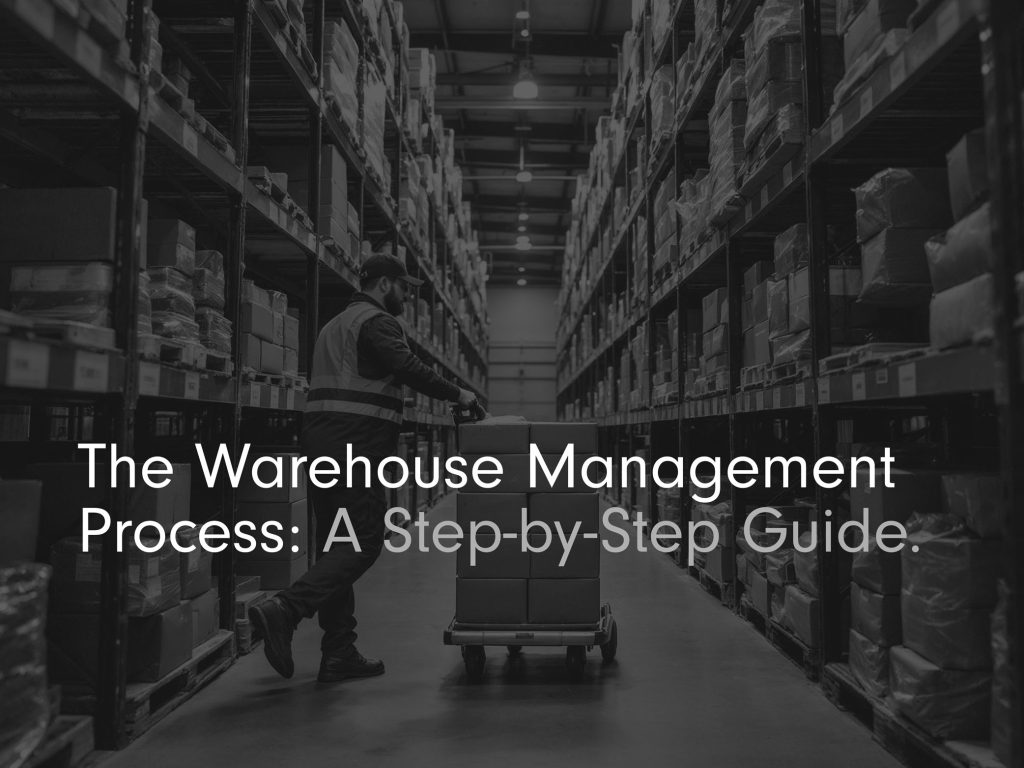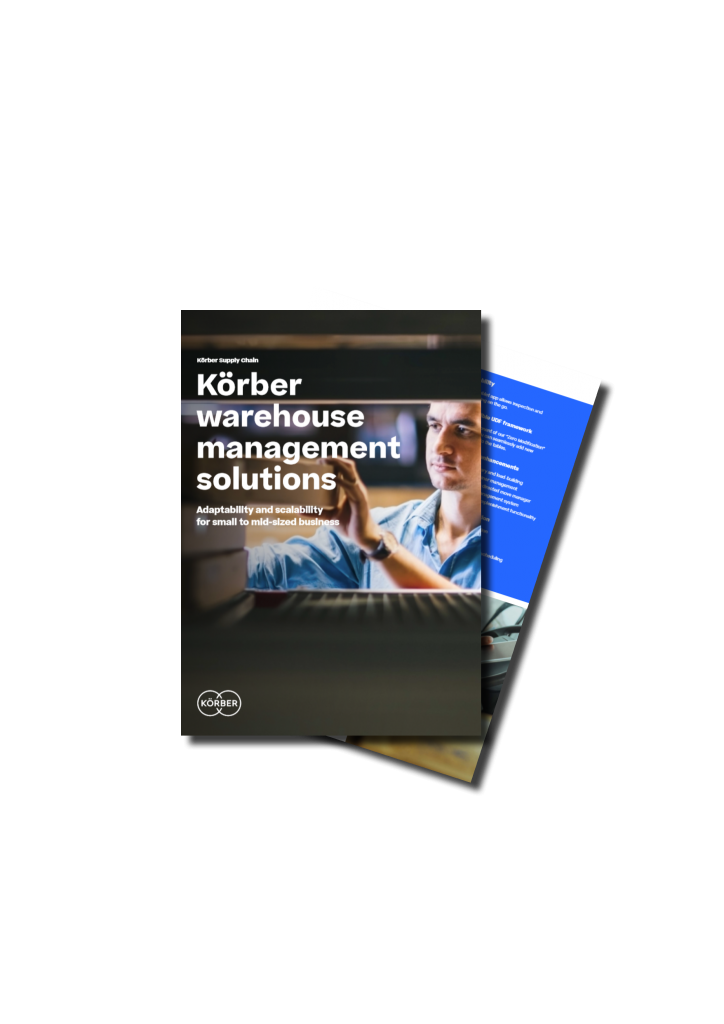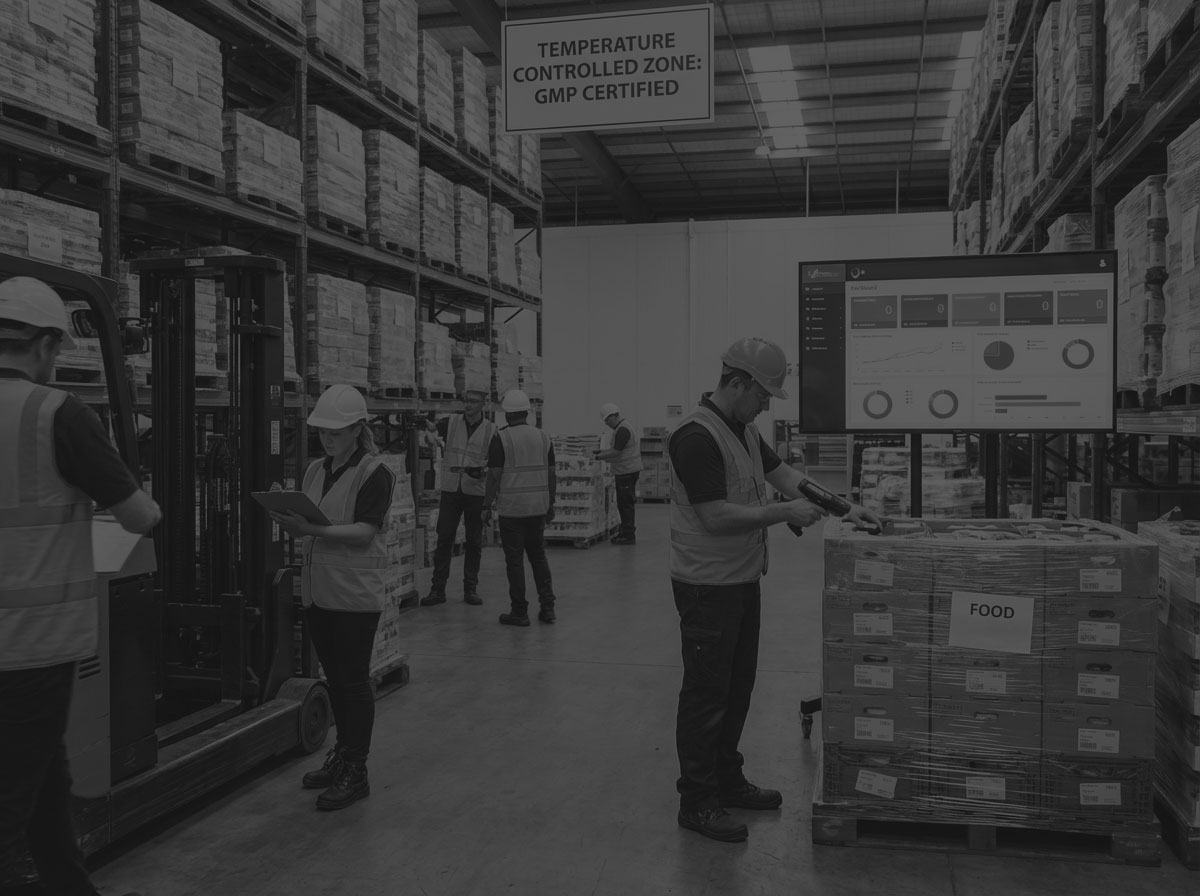The Warehouse Management Process: A Step-by-Step Guide.

The global supply chain relies heavily on efficient warehouse management. Poor warehouse processes don’t just slow operations; they create bottlenecks that affect cost efficiency, order accuracy, and – ultimately – customer satisfaction.
With constraints such as labour shortages, increasing customer demand, and the rise of automation, organisations that adopt advanced warehouse solutions can gain a critical edge. Today, we’ll walk you through a clear, step-by-step guide to warehouse management and how optimising this process can transform your business.
Key Takeaways:
- Receiving: The receiving process ensures incoming goods are recorded and inspected before entering the warehouse. This is key to maintaining organised inventory.
- Quality Assurance: After receiving, goods are checked to meet standards. Catching issues here prevents costly mistakes later.
- Putaway: Items are moved from receiving to their storage location. An efficient system saves time and maximises space.
- Storage: Inventory is organised for easy access and space optimisation, reducing operational inefficiencies.
- Inventory Management: Tracks stock levels, item movement, and accuracy. Using inventory software prevents stockouts and overstocking.
- Order Picking: Items are retrieved to fulfil orders. Streamlining this step improves delivery speed and accuracy.
- Packing: Picked items are securely packed to protect them during shipping while keeping costs down.
- Shipping: Orders are prepared and sent quickly and accurately, avoiding delays and ensuring customer satisfaction.
- Returns Process (Reverse Logistics): Handles returned goods, including inspection and reintegration. Efficient management maintains trust and recovers value.
Want more like this?
Download our free guide now.

What is Warehouse Management?
Warehouse management involves the oversight and optimisation of inventory flow, from receiving goods to storing, organising, and shipping them out to their final destination. It’s much more than simply stocking shelves and tracking products—it’s about creating a well-oiled system that ensures efficiency at every step. Modern warehouse management leverages advanced tools such as warehouse management systems (WMS), data analytics, and automation technologies, while also focusing on intelligent layouts and streamlined workflows to maximise operational success.
Why does this matter? Effective warehouse management has a ripple effect across the entire supply chain. When executed well, it leads to:
- Improved inventory accuracy, so you know exactly what’s in stock, reducing the risk of overstocking or running out of crucial items.
- Faster order processing with fewer errors, ensuring orders are picked, packed, and shipped correctly and on time.
- Lower operational costs through increased efficiency, reduced waste, and optimisation of labour resources, saving both time and money.
- Enhanced customer satisfaction due to precise deliveries and shorter wait times, helping to build trust and brand loyalty.
In today’s fast-paced business world, successful warehouse management isn’t just a nice-to-have—it’s a critical factor in staying competitive and meeting the demands of customers and stakeholders alike.

The Core Steps in Effective Warehouse Management.
1. Receiving
Efficient receiving is the foundation of a smooth supply chain operation. Every incoming shipment should be thoroughly verified against purchase orders to ensure accuracy and checked for any potential damages to the goods. This step not only prevents inventory discrepancies but also ensures that your customers receive what they expect. Automated inbound processes, such as barcode scanning or Advanced Shipping Notifications (ASN), can significantly enhance speed and accuracy while reducing the risk of manual errors during receiving.
Key Tip
Consider investing in tools like Körber WMS (now known as Infios) to automate your receiving processes and eliminate the inefficiencies of manual checks. These tools provide real-time inventory updates as shipments are received, ensuring your stock levels are accurate from the moment goods enter your facility. Additionally, automating this stage can help your team focus on other operational priorities and reduce bottlenecks, ultimately saving both time and resources while maintaining a high level of accuracy.
2. Quality Assurance
Before products are stored, they must pass through thorough quality checks to ensure they meet the required standards. This process includes inspecting for visible damage, verifying product specifications, and evaluating materials to ensure consistency and reliability. These steps are critical to avoiding costly returns, customer dissatisfaction, or disruptions in the supply chain.
Tip: Collaborate closely with suppliers to implement electronic advanced shipping notifications (ASNs). These notifications provide detailed information about incoming shipments, such as quantities, item descriptions, and delivery times. This proactive approach helps streamline the inspection process, reduces errors, and ensures products are ready for storage or distribution without unnecessary delays.
3. Put-away
Once goods are received, their efficient allocation plays a critical role in the overall efficiency of your operations. Proper put-away ensures that items are stored in locations that make them easy to access while maximising warehouse space. Directed put-away systems within your Warehouse Management System (WMS) can guide teams to the most optimal storage locations, taking into account factors such as product type, size, weight, and future picking needs. This not only streamlines storage but also reduces errors and time wasted searching for inventory later, positively impacting the entire operation downstream.
Pro Strategy
- Implement slotting techniques to prioritise high-demand or fast-moving items in easily accessible zones within your warehouse. This reduces the effort and time required for pickers to retrieve these items, improving overall efficiency.
- Organise and group items that are frequently ordered together (co-shipped items) in close proximity. This minimises the travel time for pickers and streamlines the picking process, leading to faster order fulfilment and increased productivity.

4. Storage
Effective storage is key to maintaining a well-organised and efficient warehouse. It involves balancing safety, space efficiency, and accessibility to ensure smooth operations. Warehouse managers should regularly assess and optimise storage layouts to adapt to changing product demand and seasonal sales cycles. Properly planned storage not only maximises space usage but also reduces retrieval time, improving overall productivity.
Consider:
- Implementing vertical storage solutions to make better use of unused overhead space, especially in warehouses with high ceilings, to prevent clutter and free up floor space.
- Creating temperature-controlled zones for sensitive items such as perishables, pharmaceuticals, or electronics, ensuring they remain in optimal condition throughout their storage period.
- Organising inventory based on usage frequency, keeping high-demand items in easily accessible locations to speed up picking and packing processes.
5. Inventory Management
Real-time inventory tracking is non-negotiable for efficient business operations. A robust inventory management system not only minimises discrepancies but also streamlines processes, avoids overstocking or understocking, and facilitates better demand forecasting. This ensures that businesses can meet customer demands without tying up unnecessary capital in excess stock or risking delays due to insufficient inventory.
Success Story:
Businesses like Virgin Wines leveraged advanced tools provided by Balloon One with Körber WMS, which allowed them to optimise their inventory processes significantly. By implementing real-time tracking and smarter stock control,
, while still maintaining the ability to meet customer demand efficiently. This highlights the transformative impact a well-designed inventory management system can have on both operational efficiency and overall profitability.
6. Picking
The picking stage is a critical and labour-intensive part of the order fulfilment process, as it directly impacts customer satisfaction. Mistakes or inefficiencies during this stage can result in delayed shipments, incorrect orders, or even lost inventory, all of which can damage customer trust and lead to additional costs for your business.
Optimise Picking Processes:
- Adopt zone or wave picking strategies: Zone picking involves assigning workers to specific areas of the warehouse, ensuring faster and more organised retrieval of items. Wave picking schedules picks based on factors like shipping deadlines or order priorities, making it ideal for managing high-volume periods.
- Leverage technology: Tools like handheld scanners can help reduce human error by providing real-time inventory updates and ensuring the right items are picked. Pick-to-light systems, which use illuminated signals to guide workers to the correct locations, can further improve accuracy and efficiency.
- Train your team: Ensuring your team is well-trained on the best picking practices and technologies can significantly speed up the process while maintaining accuracy.
By optimising the picking stage, you can streamline operations, minimise errors, and deliver a more reliable experience for your customers.
Real-World Example
Businesses that integrated Körber WMS reported a drastic reduction in picking errors due to real-time inventory visibility and automated picking routes.

7. Packing
At this stage, all picked items are carefully consolidated, securely packaged, and labelled for delivery. The packing process is crucial to ensure that items arrive at their destination in perfect condition. Proper packaging not only minimises the risk of damaged goods during transit but also enhances the customer experience by presenting products professionally. This includes using appropriate materials such as bubble wrap, packing paper, or air cushions to protect fragile items.
[Pro Tip]: Leverage cartonisation features available in advanced WMS (Warehouse Management System) software to select the precise packaging size for each order. This reduces waste, optimises shipping costs, and ensures a snug fit for items, further reducing the chances of damage.
8. Shipping
Shipping is the critical final step that connects warehouse efficiency to customer satisfaction. Ensuring goods leave the warehouse promptly, with complete and accurate documentation, is essential for a seamless end-to-end experience. Late or incorrect shipments can damage customer relationships and lead to costly returns or complaints.
Enhance This Step
Integrate a Transportation Management System (TMS) like Geo2 with your Warehouse Management System (WMS) to streamline logistics. This integration allows for real-time shipping updates, route optimisation, and better communication with carriers, ensuring faster and more cost-effective deliveries. Additionally, consider implementing automated labelling systems to reduce errors and speed up the shipping process.
9. Returns Process (Reverse Logistics)
Nearly 30% of all e-commerce items sold are returned, making returns a major part of the business. However, returns aren’t just a challenge—they’re an opportunity to improve efficiency and cut costs through streamlined reverse logistics. By implementing a well-designed returns process, you can assess, repair, or restock items quickly and cost-effectively, maximising recovery and reducing waste. A smooth returns operation not only saves money but also enhances the customer experience, building loyalty and trust in your brand.
Bonus Tip: Adopt a WMS
Integrating a warehouse management system (WMS) that seamlessly connects with your ERP and TMS can revolutionise your operations. A WMS provides real-time stock visibility, enabling you to track inventory more accurately, optimise storage, and reduce overstock or stockouts. Advanced analytics offer deeper insights into performance and trends, while automation can streamline tasks like order picking and inventory management. For example, a company like Centrado implemented a WMS and managed to reduce picking errors by 40%, significantly improving operational efficiency and customer satisfaction. A WMS is an investment that pays off in both time and cost savings.

Key Challenges in Modern Warehouse Management (And Solutions).
1. Skills Gap and Labour Shortage
Labour shortages remain a critical issue for supply chains worldwide, with many industries struggling to find and retain skilled warehouse staff. The increasing demand for e-commerce and fast shipping has only amplified the pressure, making it harder to meet expectations without sufficient manpower. As the recruitment of experienced staff becomes more challenging, the need for innovative solutions like automation has never been greater.
Solution
To combat these challenges, businesses can implement advanced automation tools such as robotics, conveyor systems, and AMRs (Autonomous Mobile Robots) to streamline operations and reduce reliance on manual labour. These technologies not only improve efficiency but also help to bridge the gap created by labour shortages. Additionally, tools like Körber WMS provide insightful staff performance analysis, enabling management to make more strategic decisions about resource allocation and optimise workflow.
Another key solution is to invest in the workforce through upskilling opportunities. Accessible training programs, whether through on-site workshops or digital platforms, can help employees enhance their skills and adapt to new technologies. A better-trained workforce leads to higher productivity, improved job satisfaction, and increased retention rates, creating a more sustainable workforce in the long term.
2. Optimising Warehouse Layout
A poorly optimised warehouse can significantly reduce mobility and slow down essential processes, leading to inefficiencies and higher operational costs.
Solution
- Perform regular layout audits to ensure high-demand items remain accessible. By periodically reviewing and adjusting the placement of frequently used inventory, workers can save time and reduce unnecessary movement.
- Use data-driven designs and advanced software to test warehouse flow efficiency before committing to space layout changes. Simulation tools and analytics can help identify bottlenecks and predict the impact of layout adjustments, ensuring the space is used in the most effective way possible.
3. Balancing Inventory Levels
Fluctuating demand can create significant challenges for businesses, often leading to overstocking or understocking scenarios. Overstocking ties up valuable capital and increases storage costs, while understocking can result in missed sales opportunities and dissatisfied customers, ultimately affecting both profitability and customer loyalty.
Solution
To address this, leverage real-time data and advanced forecasting tools integrated into your Warehouse Management System (WMS). These tools analyse historical sales data, market trends, and seasonal fluctuations to provide accurate demand predictions. By aligning your inventory levels with real-time customer demand, you can minimise the risk of deadstock, reduce storage costs, and ensure products are available when your customers need them.

Why You Need a Warehouse Management System (WMS).
A robust WMS acts as a central hub for warehouse data while automating repetitive tasks. Körber WMS, provided by Balloon One, offers tools that support every stage of the warehouse operation, improving:
- Inventory visibility and accuracy.
- Data-driven decision-making via real-time reporting.
- Labour productivity with optimised task interleaving and performance monitoring.
- Scalability, ensuring your warehouse can keep pace with business growth.
The Impact of Automation and Digitisation.
Automation isn’t just a buzzword; it’s the linchpin for modern warehouse success. By integrating cutting-edge tools like robotics and digital twins (virtual replicas of warehouse environments), businesses can simulate, analyze, and refine their operations, ensuring every step towards efficiency is calculated and precise. These technologies not only streamline workflows but also help identify potential bottlenecks before they become costly issues.
The ROI of Automation:
- Warehouse Automation can achieve an order accuracy of over 99.99%.
- Labour cost reduction, often cutting dependency on manual operations by a third, allowing businesses to reallocate resources to more strategic tasks.
- Faster fulfilment for peak business periods, enabling warehouses to handle higher volumes without sacrificing accuracy or speed, which is crucial during high-demand seasons like holidays.
Automation is revolutionising the way warehouses operate, helping businesses stay agile, efficient, and competitive in an ever-demanding market.

Transform Your Customer Satisfaction.
Efficient warehouse management is a key driver in improving customer satisfaction by ensuring orders are delivered quickly and accurately. Streamlining your warehouse operations through cutting-edge strategies and advanced technologies helps reduce delays, prevent errors, and maintain inventory accuracy. By optimising processes such as order picking, packing, and shipping, your business can exceed customer expectations, build trust, and foster greater loyalty over time. In today’s competitive market, a seamless and reliable fulfilment process is more important than ever for retaining happy customers.
Master Warehouse Management with Balloon One.
From layout design to advanced automation, warehouse management sets the tone for competitiveness in the supply chain. Now is the time to optimise. With Balloon One and Körber WMS, you gain tools tailored to your operations, ensuring efficiency you can bank on.
Take the Next Step
Contact Balloon One for a consultation and transform your warehouse into a powerhouse of productivity and customer satisfaction.
Download our free guide now.

FAQs About The Warehouse Management Process.
Ignoring modern data-driven tools and automation leads to inefficiencies and higher costs.
Best practices suggest reserving 10-20% extra space to accommodate fluctuations in demand and business expansion.
Most businesses report measurable improvements, including 30% faster picking, 40% fewer errors, and significant cost reductions within months.
Implementing a WMS with advanced pick planning and optimisation features, along with barcode scanning technology, can greatly improve accuracy and efficiency.
Some common challenges include inventory control, order fulfilment accuracy, labour management, and staying competitive in the ever-changing market.
Yes, a modern WMS like Körber offers seamless integration capabilities with ERP, CRM, and other business systems to streamline operations and provide real-time data visibility.
Efficient warehouse management directly affects customer satisfaction by ensuring timely and accurate order fulfilment, leading to increased





